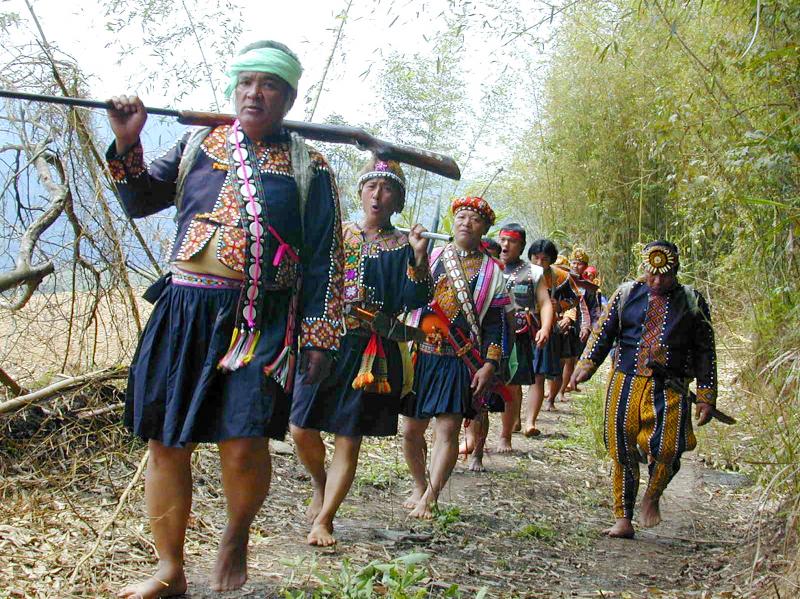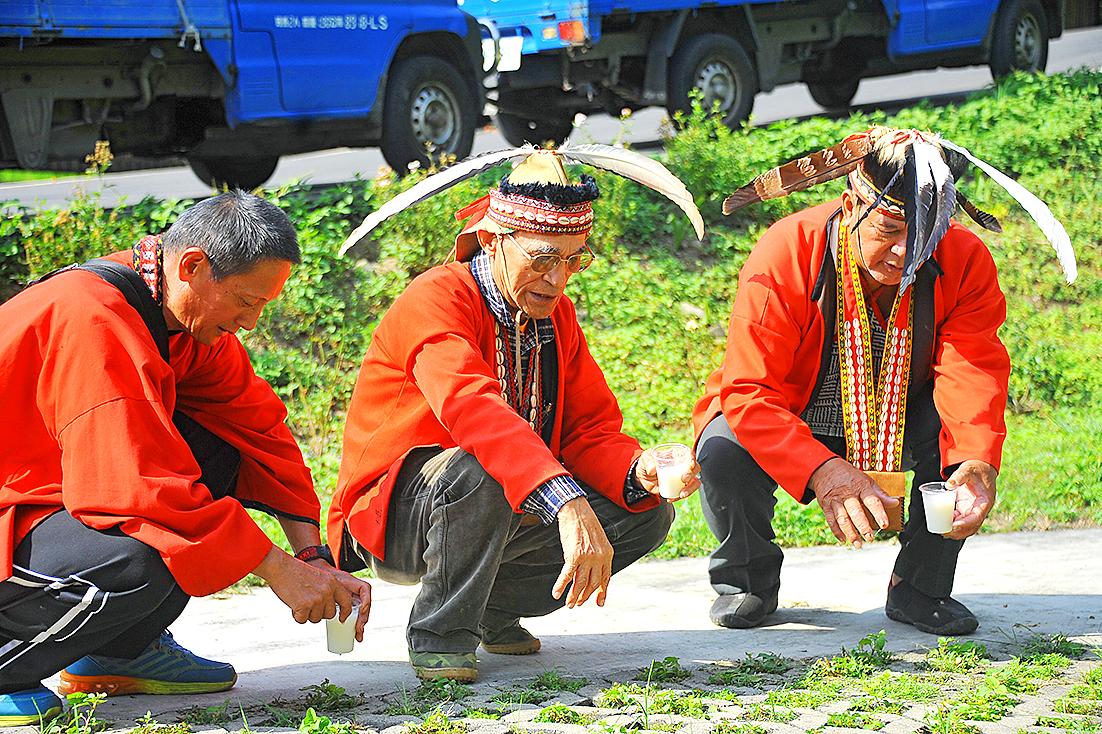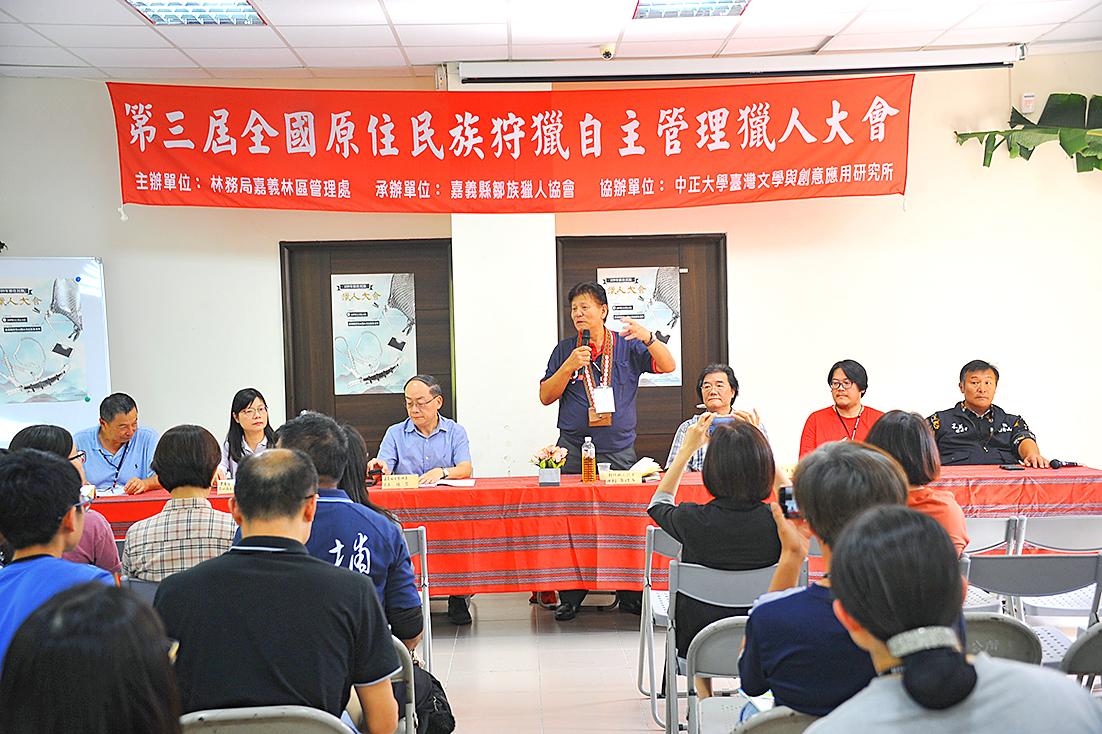Thirty young Aboriginal hunters from different tribes will be armed with a new tool early next year: an app that will allow them to report the species, location and other details of an animal that they’ve hunted to their community as well as conservationists.
It wasn’t easy for scientists to convince the hunters to report their findings. Not only is it tedious and not part of their traditional practices, there has been bad blood between Aborigines and the government over conservation laws, the landmark case being that of Tama Talum, a Bunun hunter who was convicted in 2015 of violating the Act Controlling Guns, Knives and Ammunition (槍砲彈藥刀械管制條例) and the Wildlife Conservation Act (野生動物保育法).
Furthermore, Aboriginal hunting is often stigmatized as causing environmental damage despite rampant development continuing in other areas. Reporting kills, coupled with scientific wildlife monitoring, is a crucial element of the current talks toward eventual self-governance of Aboriginal hunting, as it helps demonstrate that their practices are sustainable, says National Pingtung University of Science professor Pei Jai-chyi (裴家騏).

Photo: Chang Tsun-wei, Taipei Times
So far, the results have been favorable toward the animal populations. Pei called for volunteer app-testers earlier this month at the third annual National Aboriginal Hunter Conference (全國原住民獵人大會), where hunter associations from various indigenous communities, Forestry Bureau officials and academics gathered to present and discuss the developments and the future of self-regulated hunting in Aboriginal communities.
The conference was held at Saviki Village in Alishan Township, Chiayi County. The Chiayi County Tsou Hunter Association, which represents 335 hunters from eight villages, is the forerunner in reaching a hunting autonomy agreement with the government, hoping to sign an administrative contract sometime next year. Over the past decade, the community has essentially codified its einu (beliefs, taboos, way of life) regarding hunting into written a set of self-governance guidelines, which will not only help them negotiate with the government and explain themselves to outsiders, but also tangibly pass on the einu to young people.
“Only through participating [in this process] can we leverage with the government,” association head Avai Yatauyungana says. “We are slowly, reasonably and calmly working with the government to reclaim the rights to the land we have lost, with the ultimate goal of reclaiming the dignity of our hunting grounds and pride toward our land.”

Photo: Han Cheung, Taipei Times
SHACKLED BY THE LAW
At the end of the conference, 130 representatives from 26 Aboriginal communities signed the Taiwan Aboriginal Hunter Declaration (獵人宣言), summing up their collective vision toward hunting: Follow traditional hunting practices and maintain traditional customs; actively contribute to the sustainability of forest resources; emphasize hunting safety and fight for the right to use standard rifles; work closely with the rest of society as partners and restore their traditional territorial privileges, which includes hunting autonomy.
Hunting has never been an “occupation” in Aboriginal society. It’s simply a part of life that every man partook in, and in recent times women as well. The clash between the government and Aborigines began when the nation announced the Wildlife Conservation Act in 1989, which essentially banned all hunting since it limited the practice to “hunting zones” that did not exist.

Photo: Han Cheung, Taipei Times
In 2004, the act was amended to allow Aborigines to hunt for cultural or ritualistic purposes, but the specifics were not announced until 2012. These exceptions came with complicated procedures that often went against Aboriginal traditions. The Tsou, for example, believe that if they tell the government in advance how many animals they plan to catch on a hunt, the gods will get mad and deny them the bounty. And this still didn’t cover hunting for personal reasons, which is stipulated in the Indigenous Peoples Basic Act.
Coupled with existing mistrust toward the government, very few people actually applied to hunt legally, which led to societal stigma and recurring legal issues for hunters over the years.
In 2017, Tama Talum’s trial was suspended and the government announced that it would allow Aboriginal communities to enter a “temporary” hunting self-management phase. Forestry Bureau Director-General Lin Hua-ching (林華慶) admitted then that government regulations had “largely restricted Aborigines’ ways of life, especially hunting, as their traditions were not considered when the legislation was drawn up.”
Participating communities in the self-management program are required to form a hunter association, draft hunting self-regulation guidelines and issue hunting licenses to qualified members. They are also required to report their kills, which will be more streamlined with the app.
Since each Aboriginal community differs in structure, traditions and needs, instead of imposing another blanket law, the government plans to sign administrative contracts with each group, which can be adjusted yearly.
“The government needs to negotiate separately with each group and make decisions based on the characteristics and needs of the people. They must avoid applying a singular law to all [indigenous communities],” Avai says.
CODIFYING TRADITION
The Forestry Bureau’s Chiayi District office began working with the Tsou in 2015 as a pilot program, and in 2017, the other seven district offices also reached out to their local communities. In April 2018, the Chiayi County Tsou Hunter Association was established as the nation’s first of its kind. Today there are 11 hunter associations participating in the process.
Avai says that he began organizing the hunters in his Tfuya community around 2009 due to the various issues they faced, and later the neighboring Tapangu group joined in.
“The two groups have contrasting views on many issues, but hunting was one that we were both highly concerned about,” he says.
It took a while to come to a mutual understanding, but by the time the association formed, they were able to codify their values for the first time.
“Because these values have not been written down, they are often misunderstood and stigmatized,” Pei says. “Codifying them not only makes it easier to communicate with outsiders and self-regulate, it also helps with passing these values to younger generations.”
Each of the eight villages has a subdivision that issues hunter certificates to qualified residents and reports to the association.
“Just being able to shoot animals with a gun doesn’t make one a qualified hunter,” Avai says. “To earn the certificate, they must attend a certain number of classes per year about traditions, climate and ecology and so on. They also need to be familiar with the law. It’s not easy to become a Tsou hunter.”
Avai says that resource sustainability doesn’t conflict with their einu. Association director Mo’o Poicunu adds that there have been problems of people overhunting for profit, and that’s why self-regulation based on einu is crucial.
“Our ancestors tell us that we should not take more than what we need from the forest,” Avai says. “Our self-regulations are very strict. We are more worried about the misunderstandings animal rights activists have toward us.”
“The only thing we can do is to raise the visibility of our community by establishing a solid foundation based on our culture and knowledge of our environment,” Avai adds. “If we don’t even have that, what leverage do we have to negotiate with the government?”
But not all Aborigine communities are as cohesive or confident in their culture as the Tsou, Pei says, and some have made little progress after years of effort.
“The Tsou people’s traditional governance structure is more intact, and their chiefs have more clout than officials,” Pei says. “So they’re more willing to accept self-management based on traditional values. I also noticed that communities that are more confident in their culture are more willing to accept new concepts and use it to their benefit.”
DATA COLLECTION
Avai says scholarly support is essential as scientific backing to give more legitimacy to their traditional practices, and they are happy to work with people like Pei. And Pei says since the hunters are the ones constantly in the field, their knowledge and experience of the land is also valuable to sustainability research.
“They say that their traditional values already include sustainability, but Taiwan’s population and environment has changed greatly over the centuries,” Pei says. “They can’t just claim that they’re being sustainable. They need to show evidence.”
Pei says that his work with Aboriginal hunters is an essential part of his goal to push the government to establish modern wildlife management practices, which he says are lacking.
“By combining traditional knowledge with modern methods and technology, we can apply these thousand-year-old practices to today’s society,” Pei says. “This will bring a new era to Taiwan’s wildlife management.”
Pei is already melding old and new with the hunters by monitoring the wildlife through using cameras while having hunters report their kills. But this has been difficult to promote since they either hunt illegally or are reluctant to reveal their hunting habits. The app keeps the specific information with the hunters and scientists, and will only report to the government general statistics such as the total number of animals hunted by a community over a certain period of time.
Paiwan hunter Penapedi Paraudran, for example, says that although his hunter association in Pingtung’s Laiyi Township (來義) has been actively working with scholars with wildlife monitoring, only about half of the township’s hunters are willing to report their numbers. But it’s already a start, as Pei says Aboriginal mistrust toward Han people still runs deep. The Truku community of Dowmung in Hualien, by contrast, has the highest reporting rate of about 90 percent.
Pei says findings so far have evidence that if followed properly, traditional hunting practices are sustainable. For instance, data suggests that they hunt in a scattered pattern that agrees with modern Western ideals of responsible hunting.
Data gathering could even become an industry, Pei says, with hunters collecting all sorts of information from landslides to illegal logging for the government for profit.
“The hunters spend a lot more time in the field than scholars, and they have very detailed observations of the environment,” Pei says. “By cross-checking their findings with scientific data, we can get even better information.“
Lin agrees, saying that the administrative contracts are not just limited to hunting, but can also include ecotourism, environmental protection, data collection and other profitable ventures.
“This not only returns to Aborigines the right to their traditional culture and natural resources, it is the beginning of [the government] sharing power and responsibility toward the forest’s resources.”

In the March 9 edition of the Taipei Times a piece by Ninon Godefroy ran with the headine “The quiet, gentle rhythm of Taiwan.” It started with the line “Taiwan is a small, humble place. There is no Eiffel Tower, no pyramids — no singular attraction that draws the world’s attention.” I laughed out loud at that. This was out of no disrespect for the author or the piece, which made some interesting analogies and good points about how both Din Tai Fung’s and Taiwan Semiconductor Manufacturing Co’s (TSMC, 台積電) meticulous attention to detail and quality are not quite up to

April 21 to April 27 Hsieh Er’s (謝娥) political fortunes were rising fast after she got out of jail and joined the Chinese Nationalist Party (KMT) in December 1945. Not only did she hold key positions in various committees, she was elected the only woman on the Taipei City Council and headed to Nanjing in 1946 as the sole Taiwanese female representative to the National Constituent Assembly. With the support of first lady Soong May-ling (宋美齡), she started the Taipei Women’s Association and Taiwan Provincial Women’s Association, where she

It is one of the more remarkable facts of Taiwan history that it was never occupied or claimed by any of the numerous kingdoms of southern China — Han or otherwise — that lay just across the water from it. None of their brilliant ministers ever discovered that Taiwan was a “core interest” of the state whose annexation was “inevitable.” As Paul Kua notes in an excellent monograph laying out how the Portuguese gave Taiwan the name “Formosa,” the first Europeans to express an interest in occupying Taiwan were the Spanish. Tonio Andrade in his seminal work, How Taiwan Became Chinese,

Mongolian influencer Anudari Daarya looks effortlessly glamorous and carefree in her social media posts — but the classically trained pianist’s road to acceptance as a transgender artist has been anything but easy. She is one of a growing number of Mongolian LGBTQ youth challenging stereotypes and fighting for acceptance through media representation in the socially conservative country. LGBTQ Mongolians often hide their identities from their employers and colleagues for fear of discrimination, with a survey by the non-profit LGBT Centre Mongolia showing that only 20 percent of people felt comfortable coming out at work. Daarya, 25, said she has faced discrimination since she